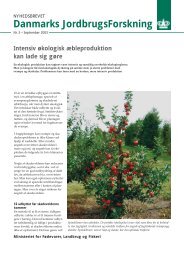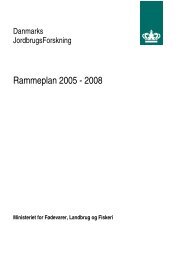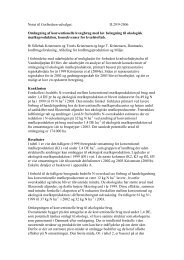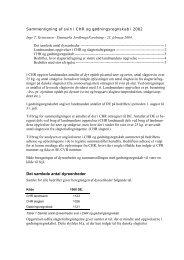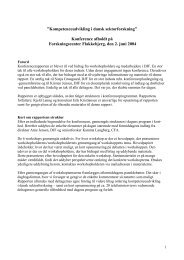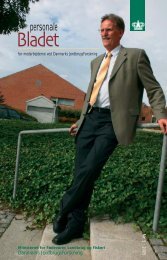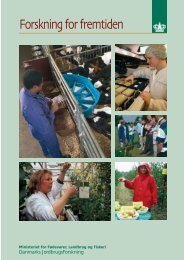Reproduction performances and conditions of group-housed non ...
Reproduction performances and conditions of group-housed non ...
Reproduction performances and conditions of group-housed non ...
You also want an ePaper? Increase the reach of your titles
YUMPU automatically turns print PDFs into web optimized ePapers that Google loves.
- Paper I -<br />
Feeding sows 16, 27 or 37 MJ ME day -1 from day 43 to day 114 in pregnancy did not influ-<br />
ence the litter size (Merk & Kirchgessner, 1984) <strong>and</strong> in accordance with this, Einarsson &<br />
Rojkittikhun (1993) suggest that feed level <strong>of</strong> pregnant sows after the first four weeks has<br />
little effect on litter size.<br />
Litter size seems to be unaffected even by low energy supply (e.g. 18.3 MJ ME) during<br />
pregnancy for several parities (Walker, 1983; Whittemore et al., 1984), though, the results<br />
should be treated with caution due to a relative low number <strong>of</strong> sows per treatment <strong>group</strong> (23<br />
followed in four gestations, 20 followed in five gestations). However, also in larger scale<br />
studies, no convincing effect <strong>of</strong> low energy supply for two (Spoolder et al., 1996), four<br />
(Young et al., 1990) or five (Gatel et al., 1987) parities on litter size has been observed. In<br />
some trials, a higher culling rate was seen among the low fed sows (Walker, 1983;<br />
Whittemore et al., 1984; Young et al., 1990) <strong>and</strong> when the culling reason was reported,<br />
main reasons were reproductive problems like for instance not pregnant <strong>and</strong> abortions<br />
(Young et al., 1990). In contrast, Gatel et al. (1987) found a slightly higher culling rate for<br />
less restricted fed sows (35.2 MJ ME day -1 ) but this was primarily due to anoestrus after<br />
weaning <strong>and</strong> leg problems. Locomotion problems are a well-known consequence <strong>of</strong> high<br />
feed intake during pregnancy (Dourmad et al., 1994). In practice, this could imply consequences<br />
for litter size <strong>and</strong> pregnancy rate because a higher culling rate will lead to a higher<br />
proportion <strong>of</strong> first-litter sows in the herd <strong>and</strong> since younger sows are less prolific than older<br />
sows, this would lead to a reduction in average reproduction performance.<br />
There are several reports <strong>of</strong> a negative relationship between feed intake during pregnancy<br />
<strong>and</strong> feed intake in lactation (e.g.Yang et al., 1989; Young et al., 1990; Xue et al., 1997) <strong>and</strong><br />
a low feed intake in lactation may reduce ovulation rate <strong>and</strong> embryo survival (Zak et al.,<br />
1997; Han et al., 2000) <strong>and</strong> perhaps even conception rate (Hughes et al., 1984) in the next<br />
cyclus. The question is, however, how high feed intake in pregnancy should be before feed<br />
intake in lactation is reduced so much that litter size <strong>and</strong> conception rate is impaired. In the<br />
above-mentioned long-term trials, the level <strong>of</strong> feed intake in pregnancy was in the range<br />
from low level (18.3-22.2 MJ ME per day) to moderate level (30.5-38.5 MJ ME per day)<br />
<strong>and</strong> in these trials, apparently no negative effect <strong>of</strong> the moderate level <strong>of</strong> feed intake on<br />
litter size was observed in the subsequent cyclus. However, whether higher feed intake during<br />
pregnancy can influence litter size negatively by reducing feed intake in lactation, is not<br />
possible to conclude based on these studies.<br />
In summary, when looking isolated upon one cyclus, energy supply after the first four<br />
weeks <strong>of</strong> pregnancy is believed to have little effect on reproduction performance. Regarding<br />
effect <strong>of</strong> energy intake in several successive pregnancies on reproduction, low energy<br />
intake (21.4 MJ ME day -1 ) for up till five parities does not seem to reduce litter size. However,<br />
low energy intake in several gestations may increase the risk <strong>of</strong> being culled due to<br />
37




